Non-standard Machining is one of the common parts in machinery. non-standard machining is an important part. It supports the transmission components and transmits torque. For us, the technical requirements and processing of shaft parts is a content about large machining. What exactly is it about? So look at the following.
The technical requirements of non-standard machining generally include the following aspects:
1. Accuracy of diameter and geometry
On the shaft, non-standard machining support journal and matching journal are important. The diameter accuracy is IT5 -- IT9, and the shape accuracy should be controlled within the diameter tolerance, which is higher than the diameter accuracy. Mutual position accuracy: if it is the general precision of the shaft, its radial circle runout, if with the journal support journal, generally take 0.01 -- 0.03 mm, high precision shaft take 0.001 -- 0.005 mm, if there are special requirements, should be noted.
2. Surface finish
Due to the machine precision, speed and other factors, the requirements for non-standard machining surface roughness are different. The surface roughness of the support journal is 0.16 -- 0.63 microns, and the surface roughness of the matching journal is 0.63 -- 2.5 microns
3. Spindle materials, blanks and heat treatment
In non-standard machining, the commonly used material is 45 steel. Through normalizing, annealing, tempering and quenching, certain strength, hardness, wear resistance and toughness can be obtained.
For shaft parts with higher rotational speed, alloy structural steel can be selected, because it will improve wear resistance and fatigue resistance after heat treatment.
The main shaft blank generally adopts forgings and round steel, which can reduce the cutting amount and improve the mechanical properties of materials.


Contact person: Mr. Zhang
Phone: 0510-85860885
Mobile phone: 15190300100
Email: 812114431@qq.com
Comment
(0)